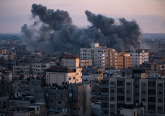 There is a tendency, even among scholars, to view civil wars as involving two actors—the “government” and “rebels.” This presumption likely arises because historical civil wars that have received the most attention—such as the American and Chinese civil wars—were generally fought between two recognized, organized combatants. Yet, many civil wars (both historical and modern) involve more than two actors.
There is a tendency, even among scholars, to view civil wars as involving two actors—the “government” and “rebels.” This presumption likely arises because historical civil wars that have received the most attention—such as the American and Chinese civil wars—were generally fought between two recognized, organized combatants. Yet, many civil wars (both historical and modern) involve more than two actors.
Take the current civil war in Syria. The Syrian government battles a series of rebel groups that generate a large number of acronyms—ISIS, SLA, SIF, and so on—and that frequently fight amongst themselves. These groups often seek to form coalitions to coordinate their opposition, but the coalitions are unstable and have difficulty controlling their constituent parts. The Syrian conflict also has a large level of external involvement, with the government receiving direct military support from Iran and Hezbollah plus a large number of additional external states and non-state actors seeking to turn the course of the war.
The Syrian opposition’s fragmentation is extreme, but the multiparty nature of the conflict is by no means unique. In fact, many of the wars that have received the most international attention in recent decades—such as in Afghanistan, Columbia, the Democratic Republic of the Congo, Iraq, the Palestinian conflict in Israel, the Darfuri war in Sudan, and Somalia—have involved several rebel groups and significant external involvement.
All civil wars contain a set of actors that have the ability to block an end to the war—in some cases there are only two of these, but often there are more, and occasionally many more. We can think of these actors as “veto players” because they have the capacity to block peace by vetoing any comprehensive settlement and continue the war on their own.
When civil wars contain more of these veto players, they last substantially longer. Multiparty conflicts such as those in Afghanistan, Kashmir, Columbia, and Somalia are among the longest lasting civil wars in the world; each has continued for more than two decades. Statistical examination of all civil wars fought since World War II has revealed that adding one additional veto player to a civil war can reduce the chances that it ends at any given point in time by two-thirds. [1]
Lengthy civil wars are extremely destructive and create significant problems for the international community. Long civil wars lead to many more deaths (both military and civilian), wreck economies, and generate massive flows of refugees and internally displaced persons. At the extreme, they can lead to state failure. Failed states represent significant security threats to the international community. Afghanistan and Somalia (as well as states at risk of failure such as Iraq today) are salient examples of what can happen to a state after years or decades of civil war.
Multiparty wars drag on because it is much more challenging to reach comprehensive settlements. Wars with more veto players present several barriers to reaching settlements in which all combatants get some, but not all, of what they want. When there are more actors the “win-set” or set of agreements that all would prefer to continued conflict is smaller or may not exist at all. It is also more difficult to assess the relative balance of power across all of the actors, and each individual group has incentives to negotiate harder to try to get the best deal as the last signer.
The presence of external actors with a strong interest in the conflict exacerbates these problems. External actors do not directly bear the costs of the war and negotiated settlements in these wars often do not directly address the goals of external parties. Consequently, external actors with strong interest in the war have significant incentives to fuel the flames of fighting until they achieve their objectives.
Given the barriers to settlement presented by multiple veto players, it is not surprising that these wars are so much longer. While the international community has been quite active in seeking to contribute to the resolution of these wars, the success rate has been low. A prominent study from 2006 evaluated 27 United Nations-led efforts at peacebuilding in civil wars, and concluded that the UN was successful about half of the time (13 out of the 27 missions).[2] However, simply dividing these cases into two-party and multiparty wars reveals that peacebuilding was successful in 10 of the 16 two-party wars (a 63% success rate), but only in 3 out of 11 multiparty civil wars (a success rate of 27%). Large-scale international conflict resolution efforts are much more likely to fail when civil wars contain more actors that can block an end to the war.
The civil war in Syria reveals many of these dynamics. Despite significant international efforts to forge agreement among the Syrian government and the moderate opposition, it is extremely difficult to envision any political settlement that the various internal combatants would agree to. The proliferation of armed groups means that it is often impossible at any given point to tell who is “winning”, or what the future course of the war is likely to be. Additionally, there are external actors—such as Iran—who have strong interests in the terms of any compromise settlement were it reached. Consequently, the war is likely to continue for many years and international efforts to find some political settlement are likely to fail.
The difficulties posed by multiparty conflicts such as the war in Syria are important to recognize, because the proportion of civil wars involving more than two combatants seems to be increasing. There is a prominent (but controversial) argument advanced by several scholars that the occurrence of war, including civil war is declining.[3] Some recent evidence supports this proposition—the number of civil wars active in a given year has declined significantly since the end of the Cold War. According to the Uppsala Conflict Data Project/Peace Research Institute Oslo Armed Conflict Dataset (ACD), there were 50 “internal armed conflicts” active in 1992. In 2013, there were 33.
Further analysis, however, shows that a greater percentage of recent civil wars involve more than two combatants. In 1992, 10 of the 50 internal armed conflicts had more than two combatants (20%). In 2013, it was 12 out of 33 (36%). These contrasting years are not aberrations—since 2000, in any one year, 30% of civil wars had more than two combatants, from 1946-1999, 20% did.
The decline in the occurrence of civil war over the last two decades is substantial, and likely due in part to concerted international conflict management efforts. The track record of international conflict management in civil wars since the end of the Cold War has been impressive, with internationally facilitated negotiated ends to long wars in Guatemala, Mozambique, Burundi, El Salvador, and between northern and southern Sudan. Yet, as the number of two-party conflicts declines, we may be left with a smaller overall number of wars but the wars that remain (like in Syria and Iraq) may be deadlier, longer, and more resistant to international efforts to resolve them.
[1] Cunningham, D. E. (2011). Barriers to peace in civil war. Cambridge University Press.
[2] Doyle, M. W., & Sambanis, N. (2006). Making war and building peace: United Nations peace operations. Princeton University Press.
[3] See, for example, Goldstein, J. S. (2011). Winning the war on war: The decline of armed conflict worldwide. Penguin; Pinker, S. (2011). The better angels of our nature: Why violence has declined. New York: Viking.






No Comment